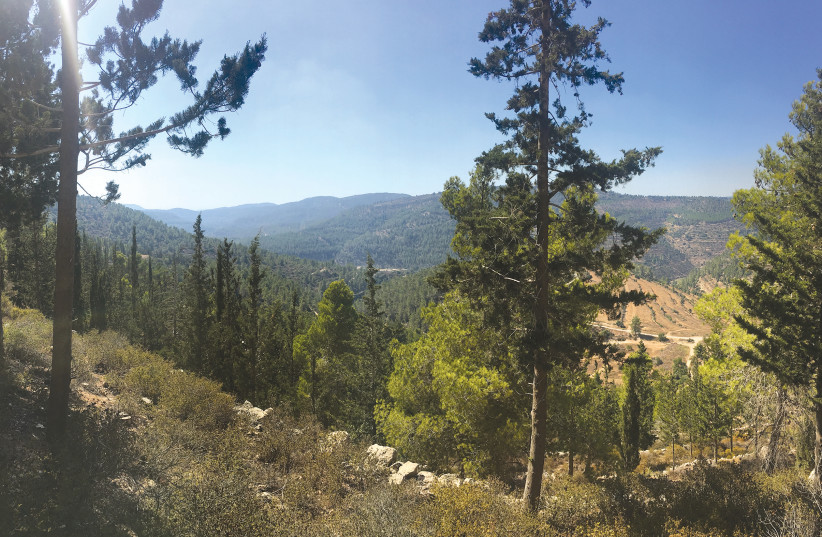I follow a path down the side of a hill, overgrown with lush, green grass. To my surprise, there are wildflowers here, lots of them. I breathe in deeply, and a mixture of wet air and flower scent enters my lungs. Looking around, I see purple lupines about to open, vibrant red anemones, delicate pink cyclamen, and many more flowers that I cannot name.
This path at the Tavor Stream Nature Reserve takes me past scenery that I never imagined could exist in Israel. Rolling, green hills tower over a bubbling stream. Down we go following the path, until we reach the river at the bottom.
As we follow the trail, storm clouds gather. We hike next to the water and cross over it, finally, coming to a stopping point at a beautiful basalt waterfall, right in the middle of the stream. As we pause to pour ourselves two cups of hot coffee, it seems as if we may soon have some rain to contend with. The sky looks grey, ominous, and extremely beautiful.
But the clouds do not burst. And as we sit there next to the Tavor Stream, under a stormy sky, I find myself dreaming about a famous biblical battle, of Deborah and Barak with the Canaanites over 3,000 years ago. That’s because this battle took place right here at the foot of Mount Tavor, and it very well may have included a storm.
It happened during the time of the Judges, before Israel’s prophets and kings. The people of Israel faced a fierce enemy, the Canaanites, led by the great general Sisera. Greatly outnumbered, the Israelites feared that they had no chance for victory, so Deborah and Barak turned to God for help.

And God intervened. As it says in the verses, “God confounded (vayahem) Sisera and all his chariots, and all his hosts.”
The word vayahem is used several times in the Torah. During the Israelite’s flight from the Egyptians at the Red Sea, vayahem is used to indicate the confusion which descended upon the Egyptians, causing them to flee from the Israelites in the middle of their pursuit. According to biblical commentators, the word vayahem could be used to indicate some sort of loud noise. Alternatively, it may indicate wetness that emerged from the Amud Anan, God’s protective pillar of cloud.
In her subsequent poem composed to offer gratitude for the miracles of the battle at Tavor, Deborah the prophetess uses poetic imagery to recount the confusion that caused Sisera’s army to fall. She tells of the river at the foot of Mount Tavor, sweeping the Canaanite army away.
Applying logic drawn from the biblical commentators, it could be that confusion came upon Sisera’s army in the form of a great storm, both noisy and wet. The storm may have filled the riverbed and caused Sisera’s unwieldy chariots to stick in the mud, allowing the Jews to decimate the Canaanite army.
Natural occurrence or divine intervention?
TO ANYONE looking on, a storm would have seemed like a completely natural event. But the words of the Torah tell a story of divine intervention.
We’ve heard similar tales of inexplicable confusion as recently as the Six Day War. During this fight for our national survival in 1967, the surrounding Arab countries attacked Israel. One of the battlefronts was in Sinai, close to Kusseima. The heavily fortified position was controlled by the Egyptians, and although the Israelis had significant forces, their numbers were far less than those generally considered necessary to defeat a fortified post such as that of the Egyptian army.
When the Israeli battalion approached the battlefield in the morning, they discovered that the Egyptians had abandoned their base and fled, leaving behind valuable equipment and territory. More disorder and flight occurred on the frontlines in Sinai throughout the course of the day, as a general panic seemed to be setting in among the Egyptian forces. The Egyptians were abandoning their posts all along the defensive line. The Israelis didn’t understand it- why would the Egyptians flee when they were still at a technical advantage?
After an Israeli attack on their air bases the night before, the Egyptian army commander, Field Marshal Abdel Hakim Amer, had become convinced that the Israelis had the upper hand, despite the fact that the Egyptian forces were mostly intact, and a resupply of fighter jets was on its way. In his panic and confusion, he instructed his army to abandon their posts, causing greater casualties and a total defeat for the Egyptians.
The unexpected triumph of the Israelis over the Egyptians at Kusseima was one of several miraculous events that lead to our ultimate victory in the Six Day War.
Surprising events can always be explained in natural ways. Was the Israeli victory in the Six Day War a miracle or a natural occurrence? Perhaps there isn’t much difference.
Just as the Torah describes divine intervention with Sisera at Tavor and the Egyptians at the Red Sea, salvation was brought to the Jews in modern-day Israel through hidden miracles. May we merit to see the same kind of hidden miracles occur on our present-day battlefields.
